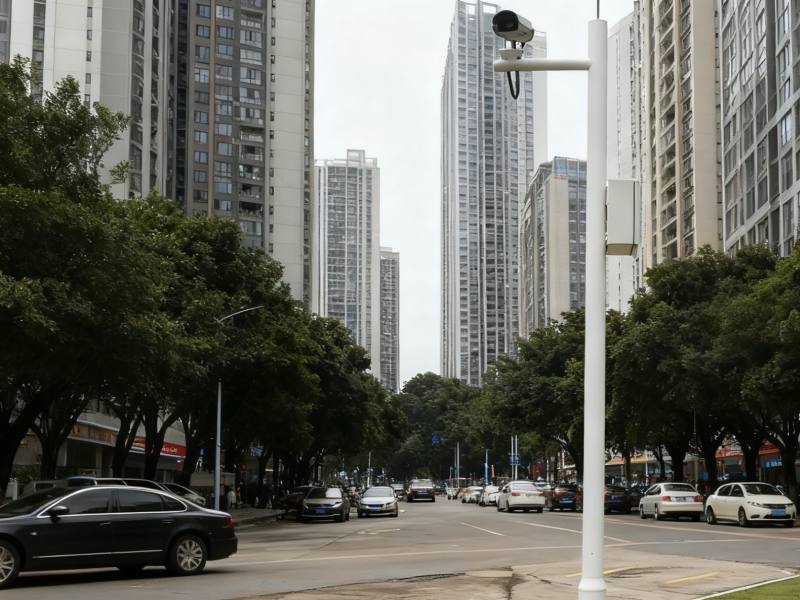The selection of video surveillance pole points needs to take into account environmental factors:
(1) The distance between pole points should not be less than 300 meters in principle.
(2) In principle, the closest distance between the pole point and the monitoring target area should not be less than 5 meters, and the farthest distance should not be more than 50 meters, to ensure that the monitoring image can contain more valuable information.
(3) Where there is a light source nearby, it is preferred to use the light source, but it should be noted that the camera should be installed in the direction of the light source.
(4) Try to avoid installing in places with high contrast. If installation is necessary, please consider:
① Turn on exposure compensation (the effect is not obvious);
② Use fill light;
③ Set the camera outside the entrance and exit of the underground tunnel;
④ Set it slightly further inside the passage.
(5) The pole point should be as far away from green trees or other obstructions as possible. If installation is necessary, it should be away from trees or other obstructions, and leave space for the trees to grow in the future.
(6) During the survey, attention should be paid to obtaining electricity from traffic police signal machines, street light distribution boxes, government, and large enterprises and institutions (such as government departments, bus companies, water supply groups, hospitals, etc.) to facilitate coordination and improve the stability of electricity consumption. Small commercial users, especially residential users, should be avoided as much as possible.
(7) Roadside cameras should be installed with attention to capturing the facial features of pedestrians and pedestrians in the non-motorized vehicle lane.
(8) Cameras installed at bus stops should be placed towards the rear of the vehicle as much as possible, avoiding the headlights of the vehicle, to capture the people getting on the bus. It should be noted that the video surveillance pole installation specifications require lightning rods and sufficient grounding protection. Installing lead grounding is the best option; it is recommended that the wires not pass through the pole body. Therefore, it is necessary to standardize the grounding and install corresponding lightning arresters for different signals to ensure the long-term normal operation of the front-end equipment. The camera is installed on the pole body. If the soil conditions on-site are good (with fewer non-conductive materials such as rocks and sand), the pole body can be directly grounded. A pit of 2000×1000×600 mm should be dug, and the bottom of the pit should be filled with 85% fine soil or wet soil. Fill the pit with fine soil and then vertically bury a 1500 mm x 12 mm rebar. Pour concrete. Once the concrete emerges, insert anchor bolts (fixed according to the pole base dimensions). One of the bolts can be welded to the rebar to serve as a grounding electrode. After the concrete has fully stabilized, backfill with fine soil, ensuring a moderate moisture level. Finally, weld the grounding wires for the camera and lightning arrester directly to the grounding electrode on the pole. Provide rust prevention and attach a nameplate to the grounding electrode. If the soil conditions on site are poor (with a high concentration of non-conductive materials such as rock and sand), use materials that increase the contact area of the grounding electrode, such as friction reducers, flat steel, or angle steel.
Specific Measures: Preliminary work is as described above. Before pouring the concrete base, lay a 150 mm thick layer of chemical friction reducer along the pit wall and embed 2500 x 50 x 50 x 3 mm angle steel within the layer. Use 40 x 4-inch flat steel to pull it down the vertical pole. The grounding wires for the lightning arrester and camera should be properly welded to the flat steel. Then weld the flat steel to the angle steel (or iron) underground. The grounding resistance test result should meet the national standard and be less than 10 ohms.
The above is what Qixiang, a Chinese steel pole manufacturer, has to say. Qixiang specializes in traffic lights, signal poles, solar road signs, traffic control devices, and other products. With 20 years of experience in manufacturing and exporting, Qixiang has earned numerous positive reviews from overseas customers. Please get in touch with us if you need any more information.
Post time: Oct-29-2025







